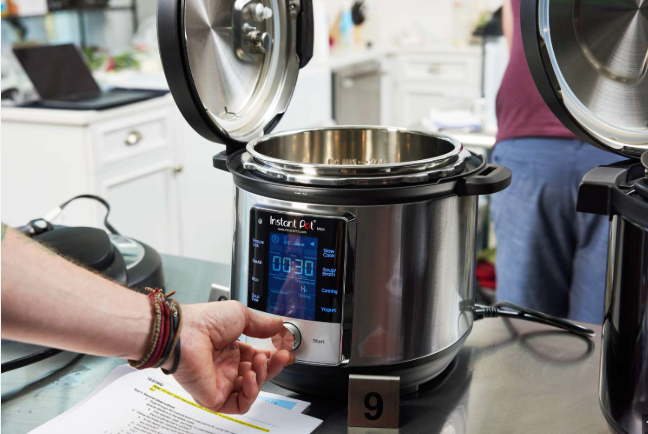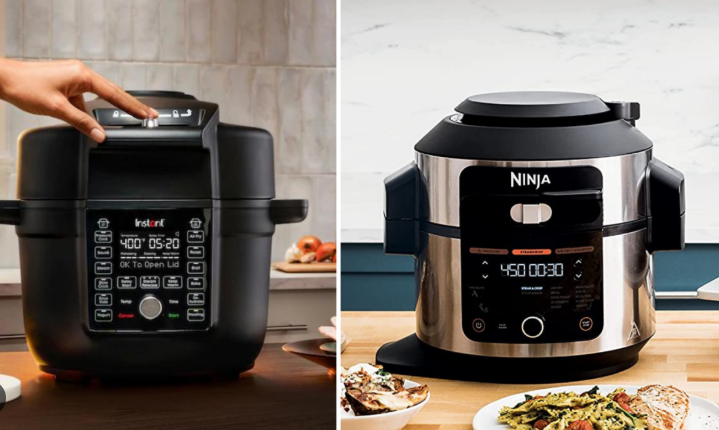Deciding between an electric cooker vs induction cooker is a significant choice when upgrading your kitchen appliances. Both offer unique benefits, but their differences in technology, performance, and practicality can greatly impact your cooking experience. In this comprehensive guide, we’ll compare these two popular appliances, exploring their features, advantages, and drawbacks to help you choose the right one for your needs. From cooker setup to cooker safety and cooker maintenance, we’ll cover every aspect to provide the best cooker guide. Let’s dive into the key factors in the electric cooker vs induction cooker comparison!
What Are Electric Cookers and Induction Cookers?
Before we compare, let’s clarify what each appliance is:
- Electric Cooker: An electric cooker, often a pressure cooker or multicooker (e.g., Cuisinart CPC-600 or Instant Pot), is a versatile appliance that uses electric heating elements to cook food. It supports multiple functions like pressure cooking, slow cooking, steaming, and sautéing, making it ideal for one-pot meals.
- Induction Cooker: An induction cooker (or induction hob) uses electromagnetic fields to heat compatible cookware directly, offering fast and precise cooking. It’s typically a flat, glass-ceramic cooktop (e.g., portable Duxtop induction cooktop) used for stovetop-style cooking.
Both appliances rely on electricity, but their heating methods and applications differ significantly. This electric cooker vs induction cooker guide will help you determine which aligns with your cooking style. For more insights, check out this electric cooker resource.

How They Work: Technology Breakdown
Electric Cooker
Electric cookers use a heating element (typically a coil or plate) beneath a removable cooking pot, often nonstick or stainless steel. Heat transfers through conduction to the pot, cooking the food inside. Models like the Instant Pot combine this with pressure cooking, using sealed steam to cook food faster. The enclosed design makes electric cookers perfect for hands-off cooking with automated settings for rice, soups, stews, and more.
Induction Cooker
Induction cookers use electromagnetic coils under a glass-ceramic surface to create a magnetic field. When compatible cookware (made of ferromagnetic materials like cast iron or stainless steel) is placed on the surface, the magnetic field induces an electric current in the cookware, generating heat directly in the pot or pan. The cooktop itself stays relatively cool, as heat is produced only in the cookware.
Key Differences: Electric Cooker vs Induction Cooker
Here’s a detailed comparison to guide your decision:
1. Cooking Speed
- Electric Cooker: Excels at reducing cooking times, especially in pressure cooking mode. For instance, white rice cooks in 4–7 minutes, and tough meats become tender in 20–30 minutes. However, it requires 5–15 minutes to build and release pressure.
- Induction Cooker: Heats cookware instantly, boiling water up to 40% faster than traditional electric cooktops (e.g., 4 minutes for 4 cups of water vs. 6–7 minutes on electric). Its rapid response is ideal for quick tasks like searing or stir-frying.
Verdict: Induction cookers are faster for stovetop tasks, while electric cookers are better for set-and-forget meals.
2. Energy Efficiency
- Electric Cooker: Efficient for one-pot meals due to minimal heat loss in the enclosed system. However, long cooking cycles (e.g., slow cooking) may consume more energy.
- Induction Cooker: Transfers up to 90% of energy directly to the cookware, compared to 70–75% for electric cooktops, reducing waste and keeping the kitchen cooler.
Verdict: Induction cookers are more energy-efficient, ideal for eco-conscious cooks.
3. Cookware Compatibility
- Electric Cooker: Uses the included cooking pot, so no additional cookware is needed, simplifying cooker setup.
- Induction Cooker: Requires magnetic cookware (e.g., cast iron, stainless steel). Non-magnetic materials like aluminum or copper won’t work without an induction converter disc. Test cookware with a magnet to confirm compatibility.
Verdict: Electric cookers are more convenient for those who don’t want to buy new cookware.
4. Ease of Use
- Electric Cooker: User-friendly with digital controls and preset modes (e.g., rice, soup, steam), perfect for beginners learning how to use electric cooker. It requires minimal monitoring.
- Induction Cooker: Offers precise temperature control but requires active cooking, similar to a stovetop. There’s a slight learning curve for those new to induction technology.
Verdict: Electric cookers are easier for hands-off cooking, while induction cookers suit those who prefer stovetop-style control.
5. Cooker Safety
- Electric Cooker: Features like locking lids and automatic shutoff enhance safety. However, steam release during pressure cooking requires caution to avoid burns.
- Induction Cooker: Safer than traditional cooktops, as the surface stays cool unless magnetic cookware is present. It won’t heat without a pot, reducing burn risks, especially in homes with children.
Verdict: Induction cookers have a slight edge in cooker safety due to their cool surface.
6. Cooker Maintenance and Cleaning
- Electric Cooker: The removable pot (often nonstick) is easy to clean, with some parts dishwasher-safe. The sealing ring may retain odors, requiring periodic soaking in baking soda.
- Induction Cooker: The smooth glass-ceramic surface wipes clean easily, as spills don’t burn on. However, it’s prone to scratches, so use soft cloths for cooker maintenance.
Verdict: Both are easy to clean, but induction cookers require less effort for spill cleanup.
7. Cost and Affordability
- Electric Cooker: Ranges from $50–$150 for models like the Cuisinart CPC-600 or Instant Pot, offering great value for multifunctionality.
- Induction Cooker: Portable single-burner models start at $60–$100, while full-size cooktops range from $800–$6,000. Induction-compatible cookware may add to costs.
Verdict: Electric cookers are more budget-friendly, especially for those not needing stovetop-style cooking.

Cooker Setup: Getting Started
Electric Cooker Setup
Setting up an electric cooker is simple:
- Unpack and inspect components (pot, lid, trivet).
- Wash the pot and accessories with soapy water.
- Place the pot in the base, secure the lid, and plug into a stable outlet.
- Run a water test (1 cup water, 5-minute pressure cycle) to check functionality.
The connect electric cooker process is straightforward, as no special cookware is needed. Ensure a reliable power source, as models (1000–1200 watts) may not suit off-grid setups without a generator.
Induction Cooker Setup
Induction cookers are easy to set up:
- Place the cooktop on a flat, stable surface.
- Plug into a grounded outlet (typically 1000–1800 watts).
- Ensure cookware is induction-compatible using a magnet test.
- Test with a small pot of water to learn the controls.
For more setup tips, visit this cooker guide.
How to Use Electric Cooker vs Induction Cooker
Using an Electric Cooker
Learning how to use electric cooker models is easy:
- Add ingredients to the pot, respecting the maximum fill line.
- Select a preset mode (e.g., pressure cook, slow cook) or adjust time/temperature manually.
- Lock the lid and start the cycle. Choose natural or quick pressure release as needed.
Electric cookers are ideal for hands-off recipes like rice, stews, or roasts, freeing you for other tasks.
Using an Induction Cooker
Induction cookers mimic stovetop cooking:
- Place compatible cookware on the cooktop.
- Select power level or temperature via digital controls.
- Cook actively, adjusting heat for tasks like frying or simmering.
Induction cookers excel for precise, high-heat cooking but require more attention than electric cookers.
Cooker Troubleshooting: Common Issues
Electric Cooker Troubleshooting
- Burn Warning: Add more liquid or clean the pot to prevent sticking.
- Slow Pressure Buildup: Check the sealing ring or valves for wear or debris.
- Unresponsive Controls: Unplug and reset; contact support if issues persist.
Induction Cooker Troubleshooting
- Cooktop Not Heating: Ensure cookware is magnetic and properly placed.
- Error Codes: Check the manual for codes like E1 (overheating) or E2 (no cookware detected).
- Uneven Heating: Use flat-bottomed, induction-compatible cookware.
For additional cooker troubleshooting tips, explore cooking tips.
Power Considerations and Cooker Battery Life
Neither appliance relies on cooker battery life, as both require a constant power supply. Electric cookers (1000–1200 watts) and induction cookers (1000–1800 watts) need stable outlets. For off-grid use (e.g., camping or RVs), ensure your power source can handle the wattage, as low-power setups like solar may require a generator.
Pros and Cons: Electric Cooker vs Induction Cooker
Electric Cooker
Pros:
- Multifunctional (pressure cook, slow cook, steam, etc.).
- Hands-off cooking with preset modes.
- No special cookware required.
- Affordable and compact for small kitchens.
Cons:
- Slower for stovetop-style tasks.
- Sealing ring may retain odors.
- Limited to one-pot meals.
Induction Cooker
Pros:
- Faster and more energy-efficient.
- Precise temperature control for stovetop cooking.
- Safer with a cool surface.
- Easy-to-clean glass cooktop.
Cons:
- Requires induction-compatible cookware.
- Higher upfront cost.
- Requires active cooking involvement.
Who Should Choose Which?
- Electric Cooker: Ideal for beginners, busy households, or those wanting a portable cooker for one-pot meals like rice, soups, or roasts. Perfect for set-and-forget cooking or budget-conscious buyers.
- Induction Cooker: Suits cooks who prioritize speed, precision, and energy efficiency. Great for stovetop-style cooking, small kitchens, or those with compatible cookware.
User Feedback and Real-World Performance
Users love electric cookers for their versatility, with comments like, “I cooked perfect rice in 6 minutes with my Instant Pot!” Some note issues with sealing ring odors or button durability. Induction cooker users praise the speed and safety, saying, “It boils water so fast compared to my old electric stove.” Drawbacks include the need for specific cookware and a learning curve for new users.
Conclusion: Electric Cooker vs Induction Cooker
In the electric cooker vs induction cooker debate, your choice depends on your cooking style and kitchen needs. Electric cookers are perfect for hands-off, multifunctional cooking at an affordable price, making them ideal for busy families or beginners. Induction cookers offer unmatched speed, energy efficiency, and safety for stovetop-style cooking, but require compatible cookware and a higher budget. By considering cooker setup, cooker safety, and cooker maintenance, you can select the appliance that enhances your culinary experience. For more tips and recipes, visit electriccookerreview.com to explore the best cooker guide for your kitchen!